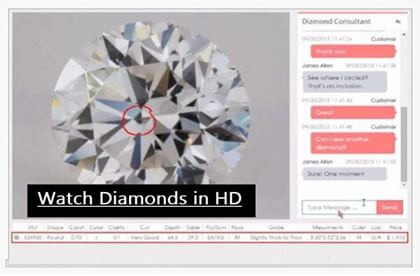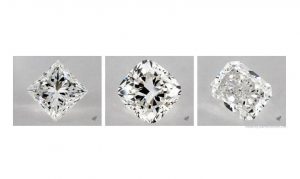Executive Summary
The culet of a diamond is the pointed end of the diamond where the two opposite pavilions meet. The pointed edge at the bottom of the diamond is called the culet, the diamond pavilion meets and close up there to prevent light from escaping through the bottom of the diamond.
Every diamond has a culet, and the culet is graded by the GIA based on the size of the opening it has. The culet grade ranges from None – Very large but the most common of the culet grade is “None” and you require this culet grade or the “Very Small” grade for the diamond cut to be graded as “Excellent”. The culet grade in diamonds are as follows;
- None: no opening under the diamond. Light cannot escape and brilliance is preserved.
- Very small: the opening is only visible under magnification. Very little light escapes but brilliance is still preserved.
- Small: small opening, more light escapes but brilliance is still high.
- Medium: noticeable opening, light is lost at the center of the pavilion through this opening.
- Large: more noticeable opening in the culet, more light is lost. Light performance and brilliance of the diamond are affected.
- Very large: very large opening at the culet. Almost all the light that enters the diamond is lost. The diamond lacks light and brilliance and appears very dull.
The ideal culet grade for any diamond is “None”. If you want to compromise on this, the least you should go to is “Very Small”. Beyond these two culet grades, the diamond cut can no longer be graded as “Excellent” and the diamond brilliance is considerably affected.
Diamonds with no opening at their culet are usually prone to chipping because of the pointed edge of the diamond. To minimize this risk, diamond cutters leave a “Very small” hole. The diamond is still brilliant and the risk of chipping has been reduced greatly.
The culet of a diamond is the bottom part of the diamond. It is the pointed end of the diamond where the two opposing pavilions meet. The two pavilion angles of the diamond meet (and close up) at the (pointed) culet to prevent the escape of light through the bottom of the diamond.
The size of culets in different diamonds may vary but the culet is present in all diamonds. According to the GIA, there are different grades of a culet and the culet grade contributes to the overall cut grade of the diamond. The most common of the culet grade is “None” and you require this culet grade or the “Very Small” grade for the diamond cut to be graded as “Excellent”.
Diamond culets have a small surface area and are pointed. For this reason, they are very susceptible to breaking. This is one of the reasons why it requires so much carefulness for a diamond to be set in jewelry. The diamond is also set in such a way that the jewelry hides and protects the culet.
Different Grades of Diamond Culet
The grading system for diamond culet ranges from None – Very Large. Grading laboratories inspect, under 10x magnification, the point on the diamond where pavilions meet and close the diamond. The presence of an opening and the size of the opening under the diamond pavilion is the grade of the culet. The culet is very important in determining how much light can be leaked by the diamond, the light performance and brilliance of the diamond and consequently, the diamond’s cut grade. The culet grade is as follows:
- None: This means that the diamond’s pavilion does not have an opening under it. It is therefore impossible for light to leak or escape from under the diamond. Therefore, the diamond’s brilliance is preserved and most or all of the light is reflected back to the observer. Diamonds with excellent cut grades usually have this culet grade.
- Very Small: This means that there is a tiny opening under the pavilion that is only visible under 10x magnification. A little amount of light escapes from the diamond through this opening. But the leakage is minimal and the majority of the light is still reflected back. It does not have much impact on the diamond which can still maintain a high level of brilliance and sparkle.
- Small: This means that there is a small opening under the diamond pavilion that is more visible under 10x magnification. Some amount of light is lost from the diamond through this opening but a lot of the light is still reflected back. So the brilliance and sparkle of the diamond will still be high.
- Medium: Here, the opening under the diamond pavilion is small but it is noticeable under magnification. Light will be lost from the diamond through this opening at the center of the pavilion.
- Large: At this grade, the opening in the culet under the pavilion is noticeable and it acts like one of the diamond facets. More light is lost from the diamond through this opening. Therefore, the light performance of the diamond is affected and the diamond usually does not have good brilliance and sparkle. An example of diamonds with large, open culet is the Old Mine Cut diamonds.
- Very Large: This is the last of the culet grade, the opening in culet of the diamond this is very large and very noticeable. Most of the light that comes into the diamond is lost and the diamonds are usually not brilliant because of their poor light performance. Modern cut diamonds and brilliant diamonds can never have a culet like this. Examples of diamonds with large, open culet are the Old Mine and Old European cut diamonds.
The Effect of Culet on a Diamond
The ideal culet size or culet grade to maximize the brilliance potential of a diamond is “None”. Brilliant diamonds generally have this culet size (or “very small” at most) and it is why they can show the level of brilliance that we love about them. This is because the closed edge of the diamond means that there is no avenue for light to escape from the diamond through the underside of the diamond pavilion. The lights are therefore reflected back and we see it in the diamond’s brilliance.
Many diamond cutters actually prefer to cut the diamond and allow it have a very small opening at the culet (under the pavilion). This is usually done to protect the diamond. When the diamond does not have an opening, the two pavilions meet and close up, forming a pointed edge at the base of the diamond. This pointed edge could pose a problem as it is susceptible to damage. That is why these diamonds are usually set in jewelry in a way that the culet is hidden and consequently protected. The pointed edge of the culet has a high risk of if it is exposed or if proper care is not taken in handling it. The idea behind cutting the culet with a very small hole is to eliminate the pointed edge and reduce the risk of damage to the diamond. With this small hole, minimal light is lost and the diamond still retains its brilliance.
Large culets, on the other hand, are not desirable. This is because they are windows that facilitate the escape of light from the diamond. When you view the diamond from the top of the table, you can also see this opening and again, that’s not desirable. Another problem with large culet is that when the culet is too large for the diamond, it affects the appearance of the diamond. The large culet will look like a dark spot under the table of the diamond. So apart from, being an opening where the diamond loses most of the light that comes into it, it now also casts a dark spot on the diamond that can be seen through the diamond’s table.
The importance of a diamond’s culet to the cut grade of the diamond cannot be overstated. So if you love a brilliant diamond, it should sink that you need a diamond with no culet or very small culet.




